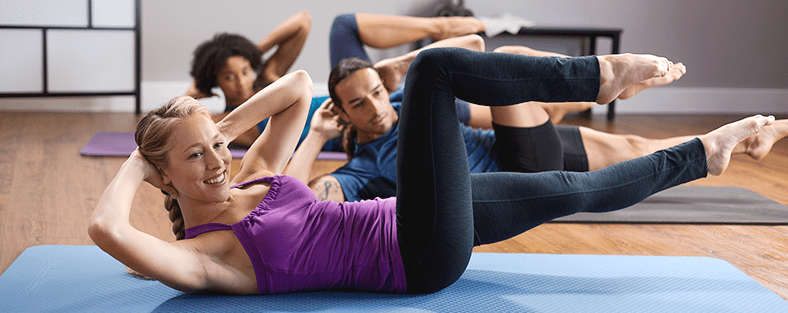What is Pilates for?
Pilates proposes to strengthen your core and improve balance through movements that are repeated and controlled through resistance, an efficient flow of movement, and energy. Practicing pilates requires concentration, breathing, and precision. These three pillars are fundamental, and in this way, they are worked on and better controlled over time. The exercises are limited to small movements that require the use of important stabilizing muscles of the back and core. The movements are started with work to control breathing, which causes the central muscles to contract. Pilates is usually done on a treadmill or specialized equipment. It is usually recommended to treat the following conditions:
- Arthritis; Urinary incontinence;
- Respiratory conditions;
- Joint injuries;
- Back pain.
Pilates benefits Pilates can promote general health, including better strength, balance, posture, concentration, endurance, and mental clarity, in addition to improving circulation and lung capacity, rapid healing, and low levels of stress, in addition to weight loss. For those who wonder what pilates is for, it’s worth checking out in detail the main benefits of pilates for your health:
1. Postural protection Correct posture Is essential to perform pilates. It is through correct posture for prolonged periods that the fundamental movements and positions are performed, as well as the treadmill and track exercises. It is only through proper body posture that full energy circulation and the benefits of Pilates can happen. Proper body posture becomes a habit for its practitioners, who incorporate the techniques into their daily routines.
2. Improves bone density Strength Training is already a well-known bone density builder, but pilates also offers surprising benefits because of endurance and weight-bearing exercises. Resistance exercise tends to stimulate the muscles, which pulls the bone to create tension, resulting in its strengthening. In Pilates, resistance training is done with device springs and resistance bands. Resistance bands for the leg and side rowing series during pilates mat exercises are also recommended.
3. Increased flexibility Many people start to practice pilates to become more flexible. Slow, controlled movements can considerably increase flexibility over time, as the body’s muscles can gradually adapt to the demands placed, improving the range of motion in many joints.
4. Leverages core strength Pilates Requires significant strength in the abdomen, especially after exceeding the most basic levels. A strong abdomen is the source of our resistance and stability, and many current practices are designed to test the strength of your core and raise it to the limit, of course in a monitored way. Pilates strengthens the abdominal muscles much more effectively and focuses on the deep abdominal muscles, such as the transversal ones, and the superficial ones, such as the rectus abdominis, which has a strong and stable core means a reduction in tension in the shoulders, neck, and joints, allowing for more free movements.
5. Increases energy Although performing pilates requires a lot of energy, one of its benefits is precisely the increase in natural energy levels. This is because it fills your body with endorphins, which make you feel good. It also improves blood circulation and optimizes breathing so that the body is functioning at peak performance levels, giving you energy for other activities in your routine.
6. Decreases stress Pilates requires a lot of focus and concentration to control body movements and ensure a safe and efficient flow of energy. This condition usually rules out any other thoughts and concerns, resulting in a reduction in the level of stress. In addition, movements and exercise efforts can contribute to the detoxification of the body and balance of stress hormone levels.
7. Cognitive improvement A conscious and focused approach to movement can increase memory retention and cognitive performance. Cognitive studies done after an exercise in which conscious movements were performed showed that people’s brain function was much greater than after a common anaerobic exercise such as weight training. 8. Increases lung capacity and circulation Breathing is one of the pillars of slow and measured pilates movements and is essential to keep your body oxygenated to prevent muscle cramps. Depending on the intensity, pilates can be a great aerobic exercise. To give you an idea, most advanced classes will be able to increase your frequency.
In general, all people who lead a sedentary, stressful, and unhealthy diet, know that they need to change, but taking the first step in pursuit of this change is always a challenge. At the beginning of a new year, we are always invaded by this feeling of change, so this is the perfect time to act. The recommendation is not to wait any longer to use the first months of the year to look for a physical activity that provides pleasure, relaxation, physical conditioning, and, of course, health. Pilates offers that and more. Much more than physical activity with proven results, Pilates is also a method that allows the practitioner to know and feel his own body. Pilates is the right modality for those who need to leave a sedentary lifestyle in the past, as it respects the body limit of each student and is easily adapted for everyone. The exercises become more complex as the student evolves in practice. There is no pressure or demand for quick results. Each practitioner follows his or her pace. So let Pilates surprise you.
Discover more from Pilates All Ages
Subscribe to get the latest posts sent to your email.
